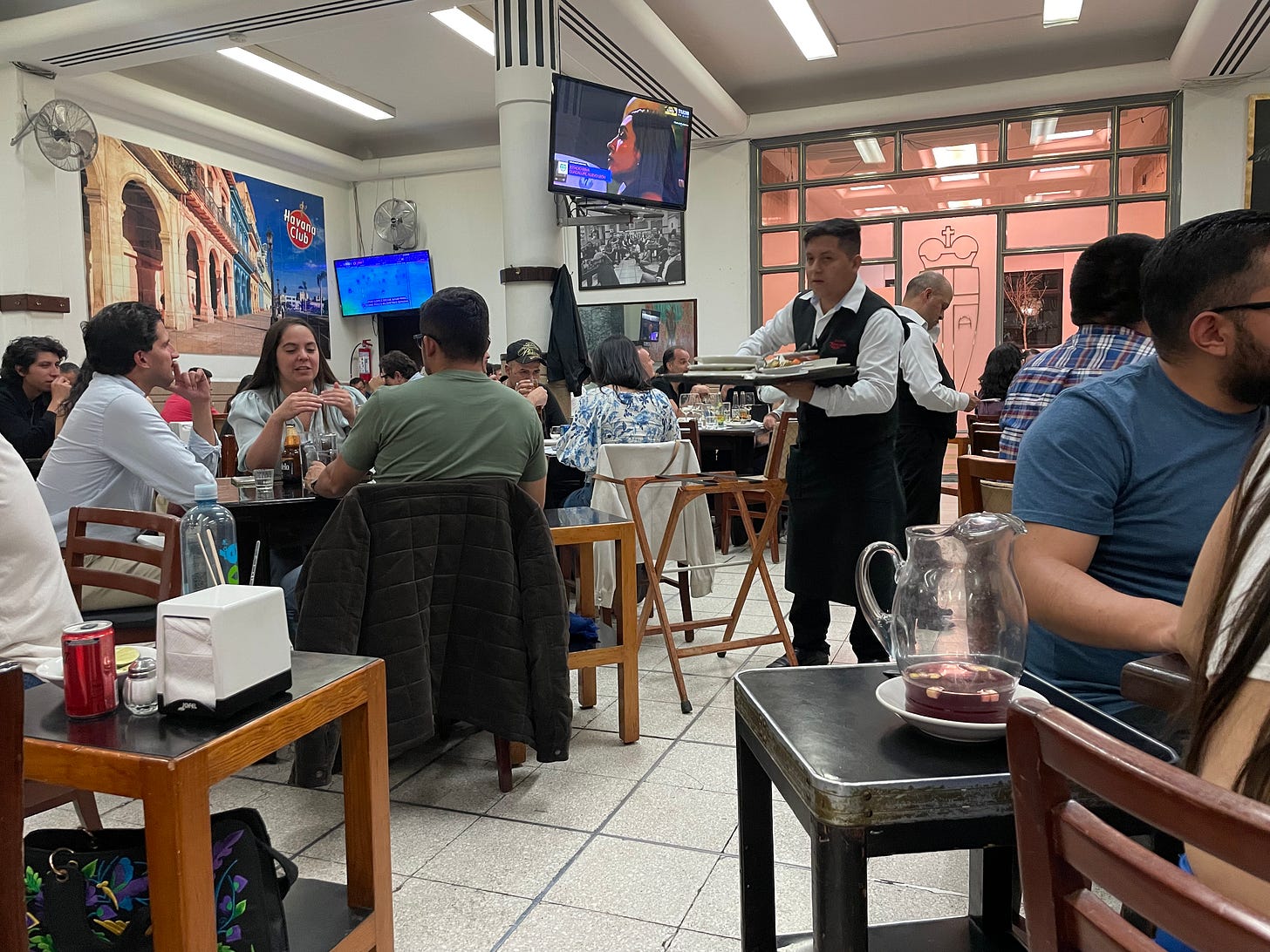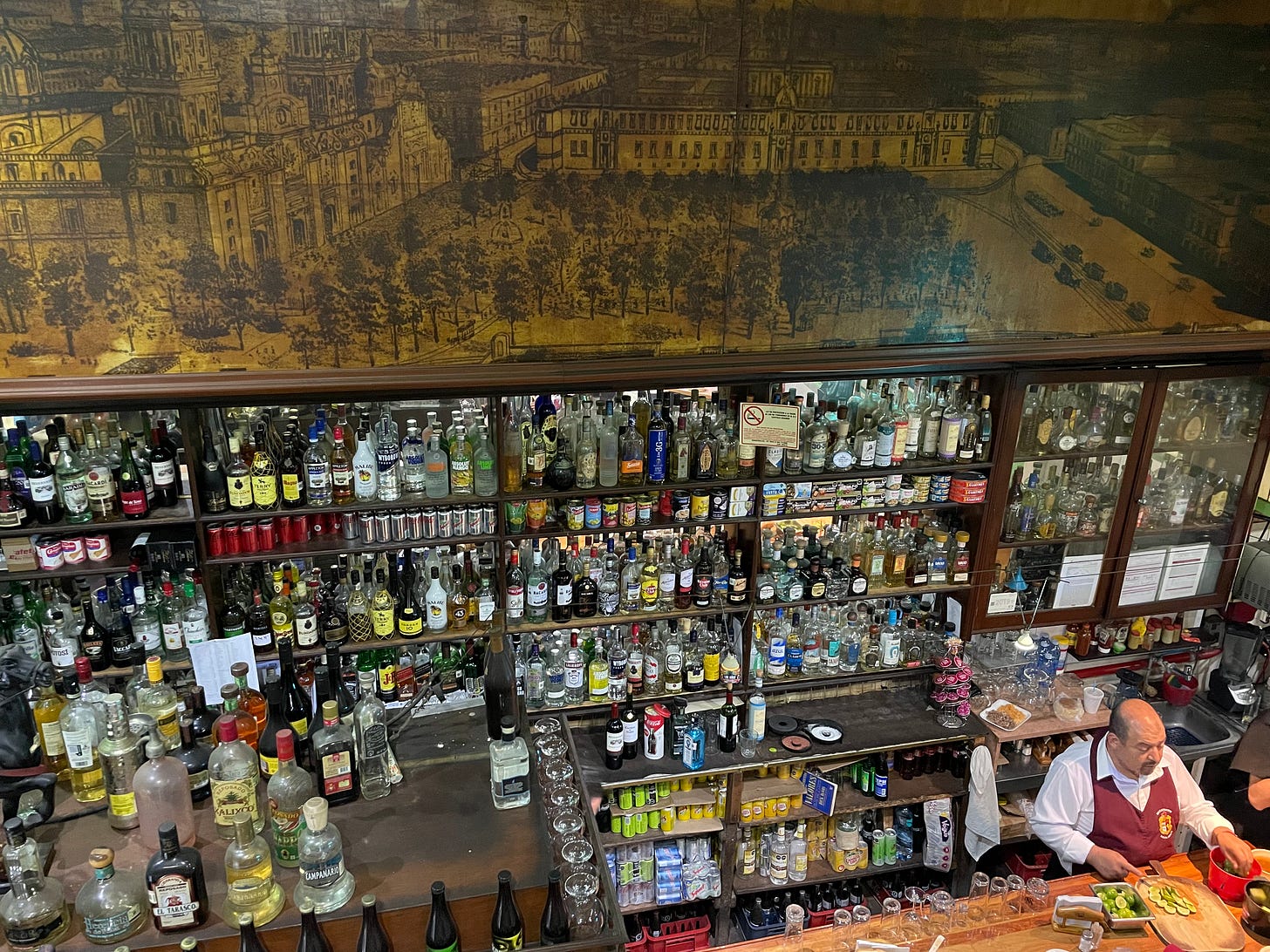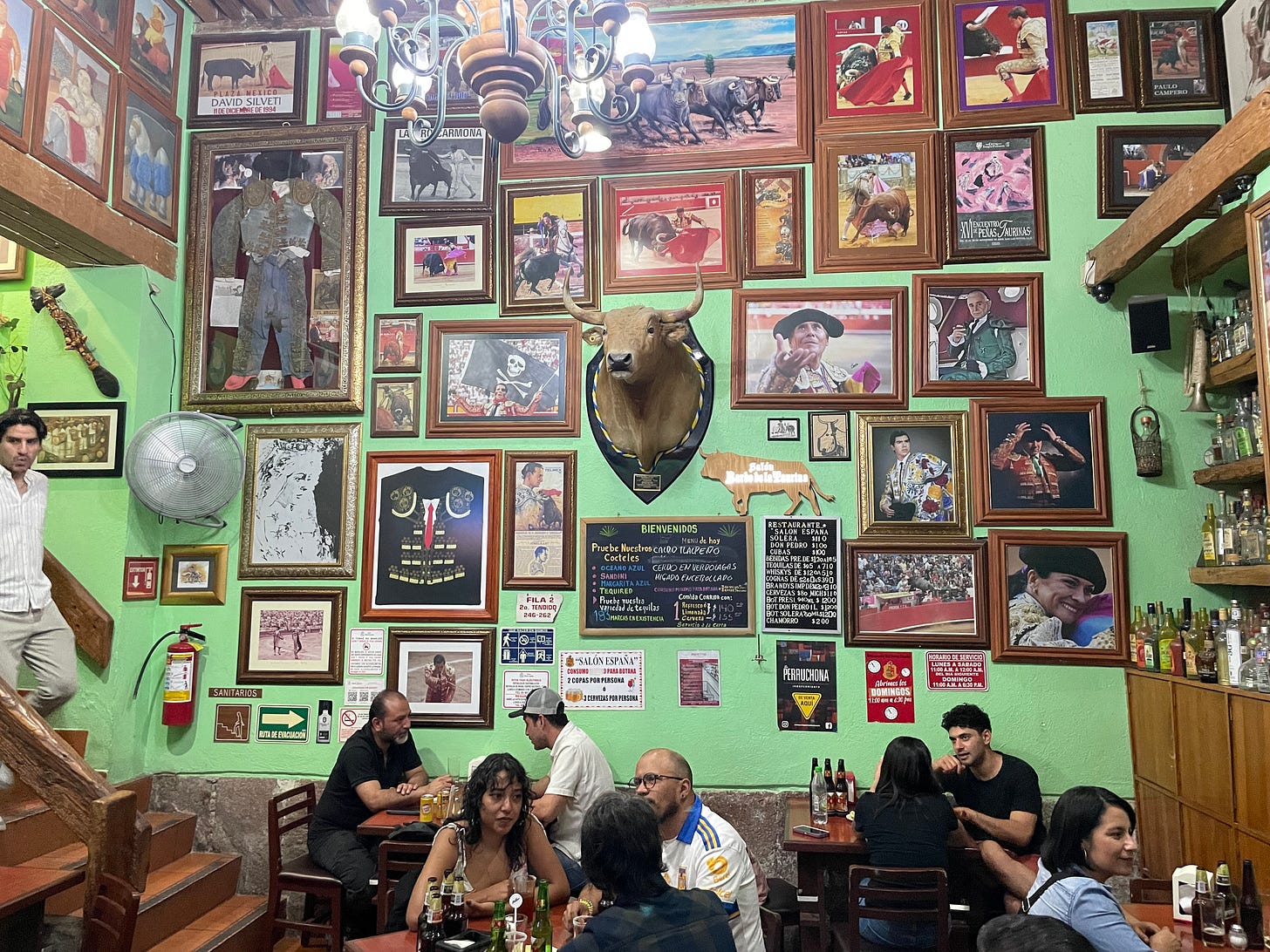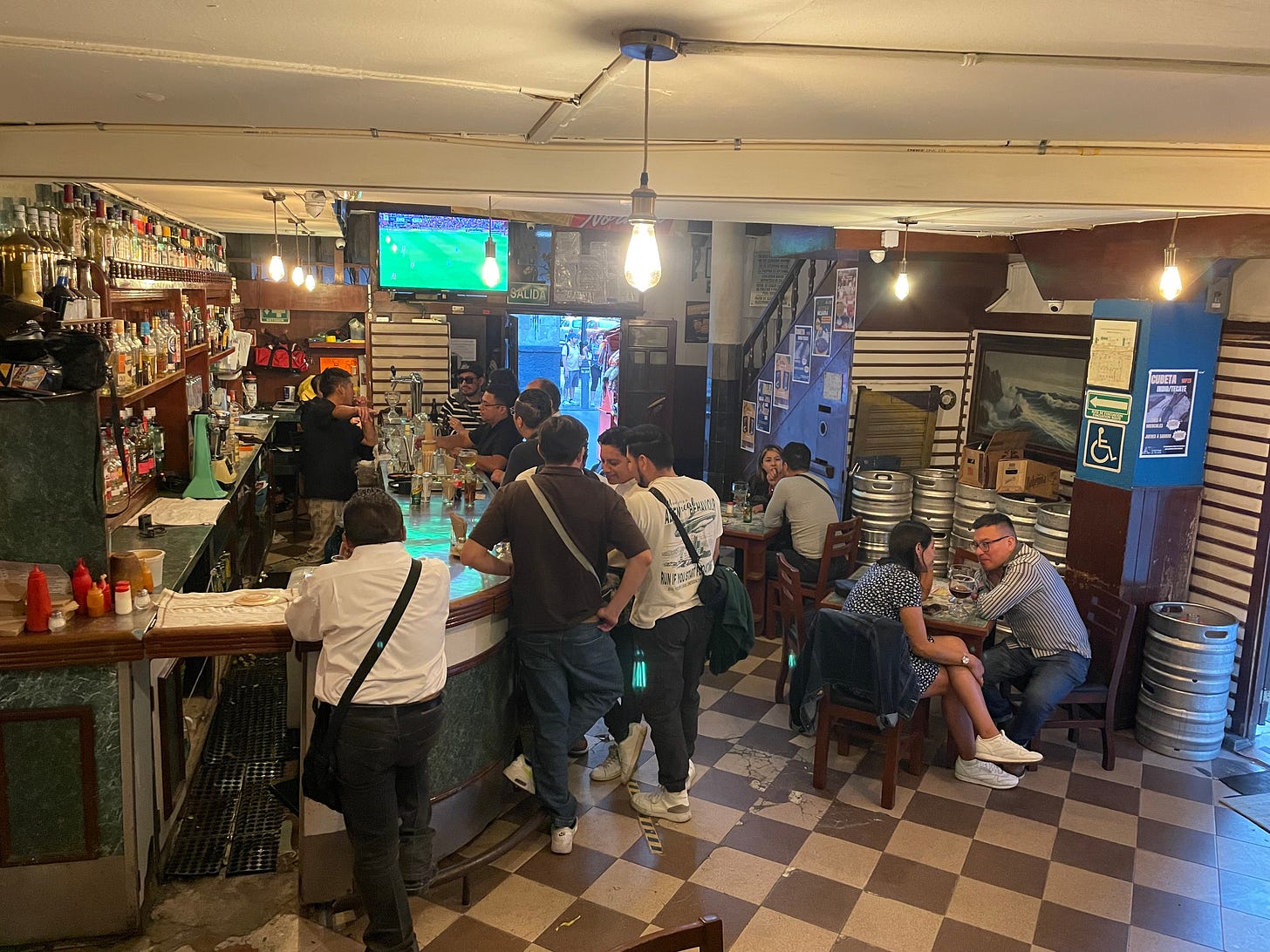In praise of cantinas
Mexican history served daily, with limes on the side.
If you want to see how a country eats, go to its markets. If you want to see how its people live, get yourself a drink. In Mexico City, cantinas are much more than watering holes. They’re places to help understand the past.
My first stop on a recent trip was for a beer at Bar Rio de la Plata just north of the central square in the historic center. Pushcarts offered elotes, or street corn, hawkers pushed cut mangos and vendors sold plush toy capibaras.
The bar was as full of life as the busy street. Inside the two-story building, my friend and I observed a constellation of Mexican society. Bar staff ran up and down the stairs in matching uniforms while university students, office workers and families sipped beer, watching soccer and listening to a jukebox.
“Every type of person is found here,” the bartender told me. “Those with money and those without.” That was because after three drinks, staff start to serve snacks including soup, rice and chicken. “Maybe even chilaquiles,” he said of the tortilla chip dish, but I wasn’t so lucky.
Unlike in dive bars today, cantinas’ central hallmark is the offering of botanas, or snacks. They started out simple, chicharron, or fried pork skin, for example, and later expanded to soups, tamales and more. Free food fuels more drinking, and more eating. As the cycle continues, it also provides an excuse to slow down and linger in conversation.
Traditional Mexican cantinas emerged in the 19th century as social spaces for men, especially working-class laborers, soldiers and politicians. The cantina helped flatten hierarchies—it was a rare place where a construction worker and a congressman might both reach for the same bowl of peanuts. Women, children and even dogs were banned, rules that didn’t loosen until the late 20th century.
Most cantinas typically stay open until the early evening, spaces to fraternize before heading home. “They make me feel nostalgic,” a young economist named Aldo Guzman Munoz told me. We spoke over a tray of sliced limes while an announcer shouted “Goal!” on television. Munoz said he frequents Rio de la Plata once a week, this time having his first beer with his girlfriend, dressed in leopard print, before the rest of his friends arrived. “They are full of tradition and I like that.”
Some cantinas represent touchstones for key developments in the country. El Tio Pepe, opened back in 1890, is Mexico City’s oldest. La Opera, another popular cantina for more than a century, flashes the European-imported grandeur popular here under the reign of José de la Cruz Porfirio Díaz Mori in 1876-1911.
But those drinking halls also became hubs for radical activity in the lead-up to the Mexican Revolution, which led to Díaz’s downfall. La Opera features a bullet hole in the ceiling allegedly from a shot fired by the revolutionary leader Pancho Villa as a protest against ruling class glamor and waste.
Cantinas are also places where life’s struggles and joys are shared. Countless crooners have sung about the establishments’ balming qualities, especially after heartbreak. Some have formed the backdrop for art, with films from the golden age of Mexican cinema featuring scenes with cantineros, or barmen. Rafael Bernal’s Mexican noir novel The Mongolian Conspiracy follows Detective Filiberto García as he meets with bureaucrats, spooks and criminals in dimly lit cantinas in Mexico City’s Chinatown amid Cold War tensions.
I walked down the street to Cantina Salón España, where bullfighting was on the television and a long table of executives swayed along to a guitarist belting out bolero ballads. A faded painting of the country’s national palace overlooked a team of waiters pouring clear liquors into various-sized glasses. Bottles and tin cans of fish were stacked along the wall, and a woman and her child sat next to a wooden trunk of chopped beef.
With slicked-back hair, cantinero Santiago Aroche passed out drinks along the bar. He has worked in a variety of drinking establishments from bars in Berlin to cruise lines, and finds the boisterous, friendly energy of cantinas to be uniquely Mexican. “It’s all gravy, baby!” he said. “Isn’t that how you say it in America?”
Framed by photos of matadors, patrons ate caldo tlalpeño, a chicken and vegetable broth spiced with chipotle peppers, and braised pork. One asked to turn on the soccer match, which prompted a chain reaction of more snacks, the guitarist stopping his song and much intent gazing at the screen. A few beers, a bowl of soup and the din of the game felt magical.

At halftime, I took a taxi from the city center to the hopping Roma district and arrived at Cantina Covadonga, a grand, old domino hall that filled up with different segments of the neighborhood. In front of the wood-paneled bar, waiters in white shirts moved around square tables with customers—sharp, deliberate, always a beat ahead in a game only they understood.
Covadonga’s style is traditional and bohemian. Artists sporting camouflage, bolo ties and tattoos drank sangria next to groups of elderly men slapping down dominos and eating from an extensive menu offering Spanish paella and ham croquettes. I worked on a shrimp cocktail and soaked in the dynamism late into the night.
In a city always in motion, the cantina remains a refuge—offering a seat, a song, a snack and a sense that life, no matter how fast it moves, is best shared. On exiting, I turned around to feel the glow one last time before the doors closed.
Joshua Levkowitz was an ICWA fellow from 2021-2023 in Turkey, where he wrote about issues related to migration and identity.





Makes me want to fly to Mexico and have a cerveza 🍺